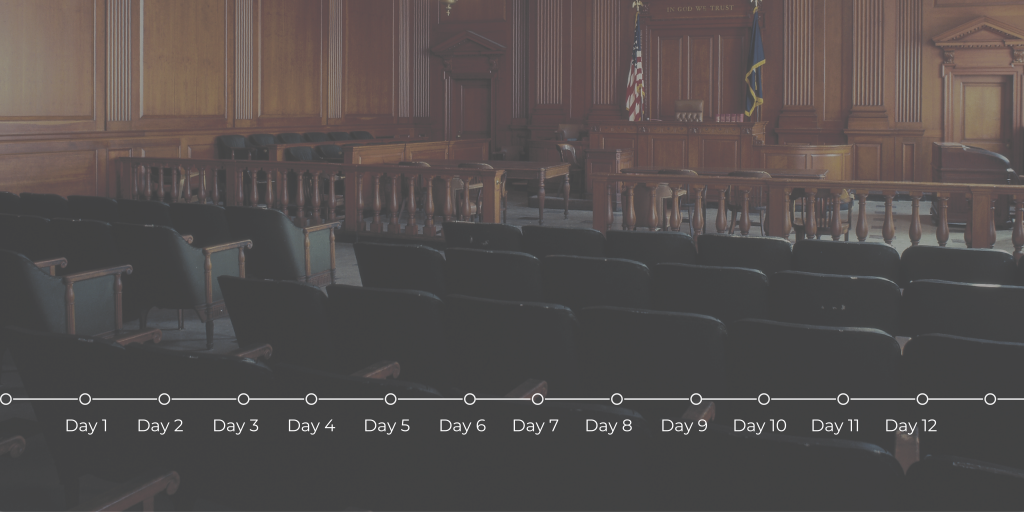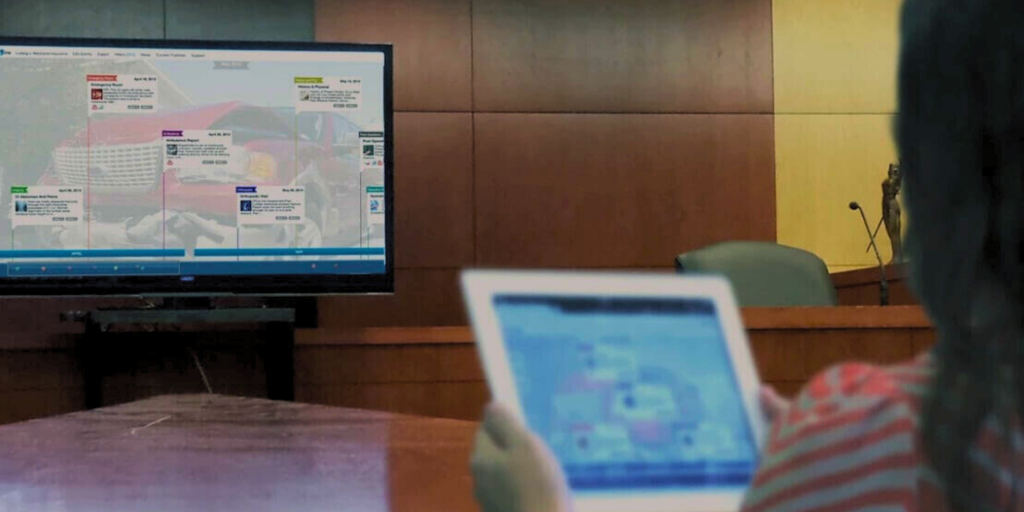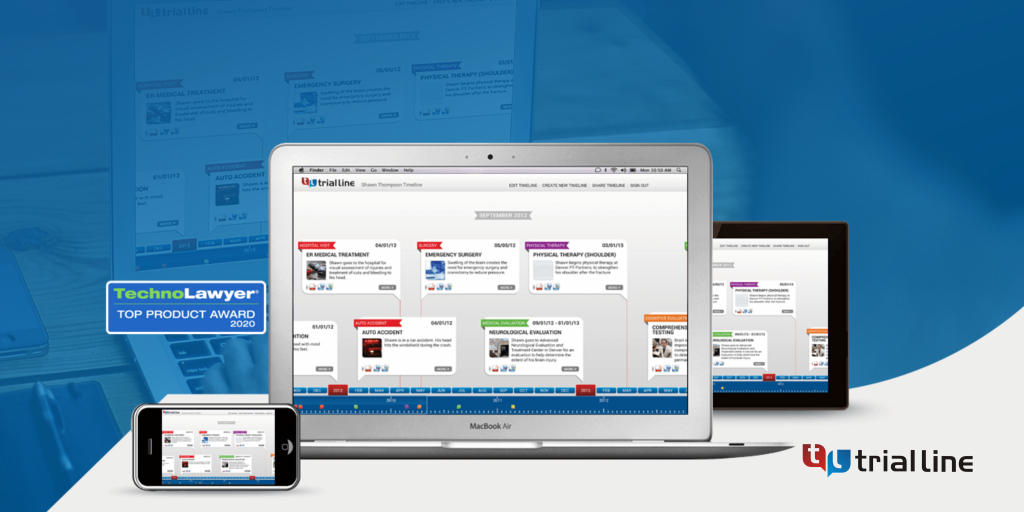The integration of technology in courtrooms is a widely debated subject within the legal sphere. It extends beyond the use of wireless microphones, audio inputs, and video cameras for coverage.
Today’s legal arena, influenced by the pandemic, is experiencing an upsurge in courtroom technology. This includes the adoption of legal timeline software to present critical events in criminal cases, the implementation of VR (virtual reality) and AR (augmented reality) in recreating crime scenes, and the use of AI-driven tools for legal research.
According to a study called Courtroom 21, an 8-person jury aged 18-70 years expressed overall support for incorporating high-tech presentation, emphasizing a preference for visual elements in courtroom proceedings. Courtroom 21 is a collaborative project that uses mock trials and various experiments to investigate the integration of technology across all facets of the legal system.
Timeline Software: An In-Demand Courtroom Presentation Technology

As various technologies become more prevalent in courtrooms, one notable tool is legal timeline software, also known as case timeline software. This software is designed to assist legal professionals in organizing chronological information related to a case. It allows users to create visual timelines highlighting key events, deadlines, and milestones. By presenting the chronological order of events in court cases, legal timeline software aids lawyers, judges, and juries in comprehending the sequence of relevant actions.
The software enhances the clarity and coherence of presenting legal information, proving a valuable asset in legal research, case preparation, and courtroom presentations. Its ability to bring order to complex legal data is increasingly recognized, making it a sought-after tool in legal firms and court trials. As a result of its effectiveness in organizing information and improving communication in the courtroom, legal timeline software is becoming an in-demand resource in the legal field.
Introducing TrialLine, an Outstanding Trial Presentation Software

Trial presentation tools have become essential not only for adapting to evolving technology but also for enhancing the efficiency of legal timeline presentation and overall document and law office management. Amid the continuous release of various tools, TrialLine stands out as a remarkable option in the market. It is a cloud-based software designed for law firms and attorneys seeking comprehensive insights into their cases and offers features for mediation, trial presentation, and storytelling timelines.
Trialline features a contemporary interface that integrates various elements of current app design. This guarantees an intuitive user-friendly experience, removing the necessity to learn new software navigation. Additionally, it facilitates effortless sharing with staff, experts, mediators, and opposing counsel. You can also establish controls and permissions for real-time collaboration. Most importantly, it empowers you to craft engaging and detailed courtroom trial presentations that could contribute to a favorable case outcome.
TrialLine’s Most Standout Features
Event by Event Detail
TrialLine allows users to systematically arrange and view a court case timeline with detailed even-by-event precision. Legal practitioners can input crucial events, milestones, and actions about the case, including filing dates, court hearings, document submissions, and other noteworthy occurrences. TrialLine seamlessly organizes these events chronologically, constructing a trial timeline that mirrors the sequential flow of events in the case. Users can conveniently explore these events using three distinct layouts (relative, carousels, pyramid) depending on their preference.
Add Text Summaries and Supporting Documents
To enhance the representation of case events in your timeline, TrialLine, a trial timeline tool enables you to include text summaries for each event. These brief explanations or descriptions offer insights into what transpired at the specific case event. These texts allow you to incorporate comprehensive explanations or theoretical notes. Additionally, for substantiation, you can attach pertinent documents, images, and videos that may serve as evidence or supporting files, synch as licenses for notable individuals involved in the events.
Edit and Share Your TrialLine on Any Device
TrialLine, being a cloud-based timeline creation software, allows users to edit and share timelines effortlessly from any device. It can be accessed through any device with internet connectivity, eliminating the necessity for specific software installations. The software is crafted to be compatible with a range of devices, including desktop computers, laptops, tablets, and smartphones. Users can smoothly transition between devices without the risk of losing any data or changes made to the timeline.
Real-time Collaboration
Multiple users can collaborate on the same timeline simultaneously with TrialLine. Edits made by one user are instantly reflected to others, fostering real-time collaborations. This guarantees effective teamwork, irrespective of the member’s physical locations or the devices they utilize. Collaborators can seamlessly access the timeline software from various devices, such as desktops, laptops, tablets, and smartphones. This adaptability empowers team members to contribute to the timeline irrespective of the location of the device they are using.
Set Controls and Permissions

In the TrialLine chronology software, users can generate distinct views when sharing the timeline with staff or other individuals. This ensures that only relevant information is shared, preventing the influence of extraneous details on opinions and mitigating the risk of biases. Additionally, this feature promotes an organized workflow. As team members often have specific roles and responsibilities, setting permissions becomes instrumental in streamlining collaboration. It enables each team member to contribute effectively through their designed roles within the legal process.
Allow Contributors to Leave Comments
Following the configuration of various permissions and controls, TrialLine empowers users to enable comments, enabling contributors to provide insights on the events shared with them. Collaborators can share perspectives, legal interpretations, or pertinent information that may not be apparent from the event description alone. This additional context enhances the overall understanding of the event. Comments also play a pivotal role in the decision-making process related to the case and prove valuable for future references, audits, or legal reviews. They establish a transparent record of the team’s consideration and thought processes.
Visually Appealing Timelines
TrialLine excels as a premiere choice for visual trial presentation software. It offers users the capability to incorporate categories with assigned color codes, ensuring events within specific categories stand out with distinct colors. Furthermore, users can enhance the visual representation by adding image thumbnails to each event, providing a snapshot of the occurrence. An image background may also be added to highlight what the case is all about. Event titles are also clearly specified, and functional icons like attachments, prominently display the number of associated attachments and comments. The various layouts provide users with flexibility in how they prefer to view the timelines.
Sharing Timelines Publicly
TrialLine stands out as one of the very few litigation timeline software that permits the public sharing of case timelines. Naturally, this involves a process wherein permissions are obtained for such sharing.
Timelines can be shared with individuals external to an organization, establishing legal precedents. This accessibility allows legal professionals and the general public to scrutinize and refer to the timeline in the context of similar cases, enhancing comprehension of legal outcomes and decisions. The public sharing of timelines can serve educational, advocacy, and awareness purposes. Additionally, an embed link can be generated to facilitate the public sharing of notable cases on law firm websites.
Case Timelines Can Be Archived
The TrialLine courtroom software enables the archiving of timelines, preserving a historical record of trial proceedings. This functionality permits legal professionals to revisit and examine prior cases, offering valuable insights for future reference, analysis, and learning. Additionally, it aids in meeting compliance and legal requirements, as certain jurisdictions may necessitate the retention of case records for specified durations. Crucially, archiving ensures a clutter-free presentation of your timelines page.
Export Timelines Into Excel Files
Users looking to effortlessly transfer, share, or integrate timeline data with other tools or software with Excel files can utilize TrialLine’s export feature. This function allows users to export the timeline file in Excel or CSV format, facilitating seamless collaboration and data exchange.
Given the widespread use of Excel, exporting timelines to this format simplifies collaboration with individuals who may not have access to TrialLine. It also empowers others to create personalized reports, conduct data analysis, and generate visualizations tailored to their specific needs.
Sign-in and Schedule a Demo with TrialLine Experts

The digital landscape is continuously evolving, and even the legal field has undergone significant changes to embrace technology. As AI (artificial intelligence) becomes increasingly integrated into various online processes, failure to digitize can lead to industry setbacks.
Given that legal processes remain integral to people’s lives, law firms and courts are actively exploring technologies to streamline tasks while adhering to compliance standards. Litigation timeline software, for instance, serves not only as a courtroom presentation but also enhances security measures for law firms.
Although litigation timeline software offers convenience, the management of files may become complex, particularly in terms of document storage. As technology integration progresses, there is a risk of complexities such as accidental deletions or the potential for ransomware attacks via emails. Some may even have a hard time understanding legal consequences and ethical considerations when using a timeline tool. To address these challenges, TrialLine, a timeline software designed for lawyers, and medical chronology software for legal medical consultants, encourages users to familiarize themselves with the tools. They may also sign up for a 14-day free trial and schedule a demo with our experts to address any inquiries.
Disclaimer: The information provided on this website does not, and is not intended to, constitute legal advice; instead, all information, content, and materials available on this site are for general informational purposes only. Information on this website may not constitute the most up-to-date legal or other information.

